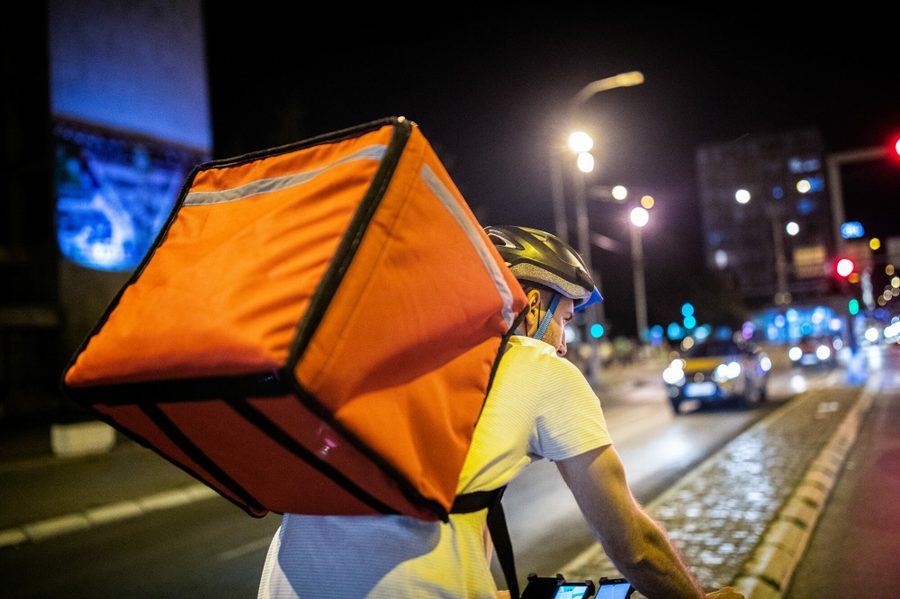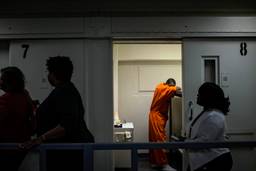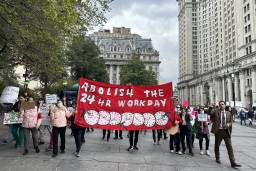Speed Grocery Delivery Workers Are in a Dangerous Race
A new industry of venture-capital-backed startups claim their workers are fast. Are they faster than regulations?
Maggie Duffy

NEW YORK — Anthony Hom offers tips to delivery workers on his YouTube channel, Ride With Anthony. In one 15-minute, day-in-the-life video titled “Delivering Groceries Almost Kills Worker NYC,” Hom records himself on an electric bicycle delivering groceries through the streets of Manhattan, through a 20 mph wind he says is “pushing him sideways,” past a street barrier that blows into his path and avoiding a car that swerves without signaling.
That day, Hom was delivering for startup 1520, which launched in Manhattan in January 2021. It promised delivery in 15 to 20 minutes “or it’s free,” hence the name.
Grocery speed-delivery services surged in New York in 2021, heavily backed by venture capital. Already, expansion is outpacing protections, experts and advocates say (though 1520 has now shuttered, having drained its initial funding of $7.8 million). Delivery workers for the startups commute using e-bikes, and sometimes e-scooters, often provided, and branded, by the company they work for.
The ads are hard to miss, complete with neon color palettes and obscure names (see JOKR and Gorillas) and websites claiming the pasta will be “delivered before the water boils.”
The 20-minute delivery window is possible because of strategically located, company-owned micro-warehouses that each stock a limited supply of curated products, with an operating radius of about 2 miles (New York City Councilwoman Gale Brewer has alleged the “dark stores” are illegally located in commercial and residential zones.)
Hom started as a full-time delivery courier for 1520 in September 2021, motivated by the prospect of being an employee with hourly pay and the requisite benefits and protections, which he would not receive as an independent contractor, where pay scales can be radically different each day. On paper, the difference seems like a big move for the delivery and gig-economy industry; the majority of delivery workers for third-party apps are classified as independent contractors, which leaves them ineligible for minimum wage protections, sick pay, workers’ compensation, unemployment insurance and other benefits.
Without robust, enforced regulations, however, some advocates say the move is more about public relations than social responsibility.
“Speed delivery is testing new business models to maximize their profit, create competitive advantage and grow in the app delivery market,” says Ligia Guallpa, executive director of the Worker’s Justice Project. “They need a reliable workforce that can be 24/7— and this means paying the minimum and giving minimum protections, so they can control the labor more rapidly.”
Speed-delivery workers in New York City are covered under Administrative Code 10-157, which sets standards for businesses using bicycles for commercial purposes, according to Vincent Barone, press secretary for the city Department of Transportation. But Hildalyn Colón Hernández, policy director for the Worker’s Justice Project, says speed-delivery companies often do not comply. She cites examples such as providing reflective uniforms for safety and company identification on the bikes, guidelines that restaurant delivery services are required to follow, while some speed-delivery services are lacking, she says.
Meanwhile, the delivery industry itself is rapidly changing. “We have an industry that is emerging extremely fast, with a slower government sector,” Colón Hernández says. In September 2021, for example, the New York City Council passed legislation granting workers for third-party delivery apps (like Uber Eats and DoorDash) new protections, including access to restaurant bathrooms and transparency about daily compensation — but that particular legislation does not cover speed-delivery from micro-warehouses.
Hom quit 1520 because of “a lot of close calls” and the inflexibility of his schedule, he says. The average shift for 1520 workers was 12 hours according to Hom, but he says no delivery worker should be out longer than 8 hours: “Your body gets fatigued, not just your muscle but your instincts. That’s when human error takes place.”
As an employee, he says he was on the clock regardless of weather conditions. “When it’s raining, snowing, really cold outside, the hazardous work conditions, you still gotta deliver these groceries,” Hom says, adding: “If you refuse to, you’re probably going to get written up.”
When remnants of Hurricane Ida swept through New York in September 2021, images of delivery workers fulfilling orders for those hunkered down at home circulated online. One video, which shows a rider carrying an order through waist-deep water, prompted Rep. Alexandria Ocasio-Cortez to tweet, “If it’s too dangerous for you, it’s too dangerous for them.”
To Colón Hernández, the unacceptability of this risk should be obvious. “If there is a hurricane, no one should be out there,” she says. She adds that, even in wintry conditions, “They are out there doing the work that nobody wants to do. They need to be compensated fairly.”
Veena Dubal, a San Francisco-based law professor whose research centers on the gig economy, says, “In an industry where there is such a high rate
of injury, so much wear and tear on one’s body and health, there has to be a wage premium,” Dubal says. “These have to be good jobs, not make-it-by-the-seat-of-my-pants jobs.”
Josh Wood, a delivery worker for Uber Eats covered by the new delivery legislation, says his experience with Los Deliveristas Unidos (“Delivery Workers United”), an organizing collective created by the Worker’s Justice Project, has bolstered his beliefs in workers’ rights.
“Every worker,” Wood says, “should have a union, have a group of advocates for them, and should be in an industry that’s regulated.”
Maggie Duffy is a Brooklyn-based writer and an In These Times editorial intern. She is a graduate of Occidental College where she earned a degree in sociology. She most recently worked as a researcher for American Friends Service Committee.







